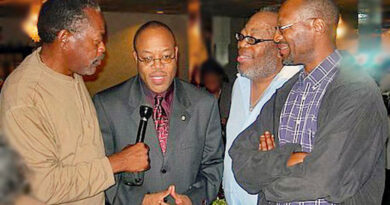4 Exercises to Steal From Misty Copeland for a Strong Ballerina Body
Try the professional ballerina’s go-to moves for maintaining a sculpted physique.
When you think of a ballerina body, you may picture a petite, slender physique. But many dancers have rejected that rigid idea of what a ballerina is supposed to look like—and instead, they’ve led a shift towards embracing a diverse range of athletic ballerina bodies. One woman who’s played a major role in that movement is none other than Misty Copeland, the iconic principle dancer at the American Ballet Theater.
“We are real women and ballerinas, muscular, feminine but also strong, lithe but also curvaceous,” Copeland writes in her new book, Ballerina Body: Dancing and Eating Your Way to a Leaner, Stronger, and More Graceful You ($30, amazon.com). But Copeland doesn’t pretend she always felt so confident in her skin. “None of it was easy. Not my climb in the ballet world, not my arrival at a place of personal contentment and peace, not my journey to the body I stand in.”
Her book is her way of helping other women reach the same state of body confidence that she now exudes to the world. “I dream of sharing what I’ve learned—of showing women everywhere how to reach their body goals and achieve what they see as their best selves,” she says.
For Copeland, that has meant prioritizing exercise, as an integral and positive element of her day. “Working out, so essential to our mental and physical well-being, can and should be woven through every part of our lives,” Copeland says.
Below are four exercises that she incorporates in her cross-training routine, to help maintain her ideal ballerina body—“one that is lean but sinewy, with muscles that are long, sculpted, and toned.” But you certainly don’t have to be a dancer to reap the benefits of these challenging moves. Try them out to get toned from head to (pointed) toe.
Relevé

“Relevé” means “raised,” or lifted, and describes the position when you rise onto the balls of your feet (demi-pointe) or onto the toes (pointe) of one or both feet.
a. Begin in first position. Demi-plié, then stretch your knees and rise onto demi-pointe (relevé). Repeat this three times and old on the count of four. When done to music, the counts are to the timing of the music.
b. Repeat once. When you get stronger, you may do four repetitions.
Remember to hold your posture. The flexing and pointing also prepare and strengthen your ankles to allow you to stand on demi-pointe (or en pointe, if you are an advanced dancer).
Balancing Adagio

“Adagio” refers to the slow movement in the ballet technique. As much as the adagio is about flexibility, strength, and fluidity in the movement, learning this exercise on the floor will give you an advantage before approaching it standing. On the floor you acquire a sense of balance and where your weight should be in order to leverage it to make you legs appear higher and more extended in opposition to our upper body.
This exercise should be done slowly to improve balance, alignment, abdominal strength, and stamina.
a. Start by sitting with your legs together on the floor in front of you.
b. Lift your legs into the air by bending your knees, holding the backs of your things with your hands with your legs still bent and parallel to each other.
c. Leaning back, with your back straight and the backs of your thighs (hamstrings) leaning into your hands, slowly lengthen both legs into the air until they are fully straight, making you into a V shape. Bend your knees so the tips of your toes touch the floor. Now do the same with each leg, alone, keeping the tips of the toes of your other leg posed on the floor.
d. Repeat the sequence, beginning with the other leg, when doing the single-leg section.
Seaweed

This exercise is great for freeing and lengthening the spine and for centering and strengthening the core.
a. Begin lying on your back, your legs together and parallel and your feet pointed.
b. Bend your legs slowly, bringing them off the floor, still bent, and lifting your feet off the floor as well, while your back hugs the ground.
c. Keeping your lower back on the floor and your shoulder blades drawn down toward your waist, curl your upper back off the floor, around your lower abs. Your arms should act like seaweed being moved by the motion of the tides, around and behind your lifted legs.
d. Float your upper back and arms down to the floor, legs still bent, body still energized.
e. Repeat four times, bringing your legs gently toward your head as your core and upper body lift, igniting the lower abdominal muscles.
f. After the last time, hold one hand or wrist (depending on the length of your arms) with the other, behind your thighs.
g. Lengthen your legs straight into the air, pressing the backs of your legs into your arms.
h. Propel your legs to the floor, arms still around them, until you get close to the floor. Then open your arms to the sides and move them forward toward your feet, over your head.
i. Your upper back should bend forward over your legs as you transition from lying to sitting, with the backs of your hands on the floor to help stabilize and keep the backs of your legs on the floor.
j. Roll down through your spine until your back is on the floor and you are in the starting position, with your shoulders relaxed. Repeat two to four times.
Dégagé

“Dégagé” means “disengaged.” When preparing for dégagés in particular, but whenever you’re lying on the floor, you should feel like you are standing or jumping—not lying on the sand at the beach!
This exercise is good for length, strength, and alignment. Be sure to press the parts of your back and body that are touching the surface of the floor to the floor, allowing your working leg to float up, initiating the movement with your inner thighs and the backs of the legs rather than the top of your thighs (quadriceps).
a. Begin lying on your back with your feet in first position (heels together and toes apart, feet pointed).
b. Place your arms at your sides with your palms facing down; you can vary the positioning of your arms depending on what makes you comfortable, as long as your arms don’t go above your shoulders.
c. Keep your legs elongated, straight on the floor.
d. Use your palms and arms by pressing them to the floor. This will help to strengthen your core and align the spine.
e. Lift one leg two or three inches from the floor, with your toes still pointed out, by pressing the standing leg (again, whether you’re standing or lying on the floor, the standing leg is the one that is not moving; it helps to maintain balance), your arms, and your head into the floor. This will help you to lift the working leg while maintaining stability throughout your body. Do four dégagés with one leg front, then switch legs and do four with the other leg front.
f. Now do four dégagés to each side. For these, your working leg stays on the floor, brushing along the floor as it extends to the side. Do not disturb the balance of the pelvis or the back as you move the working leg.
Excerpted from the book BALLERINA BODY by Misty Copeland. Copyright 2017 by Misty Copeland. Reprinted with permission of Grand Central Life & Style. All rights reserved.


